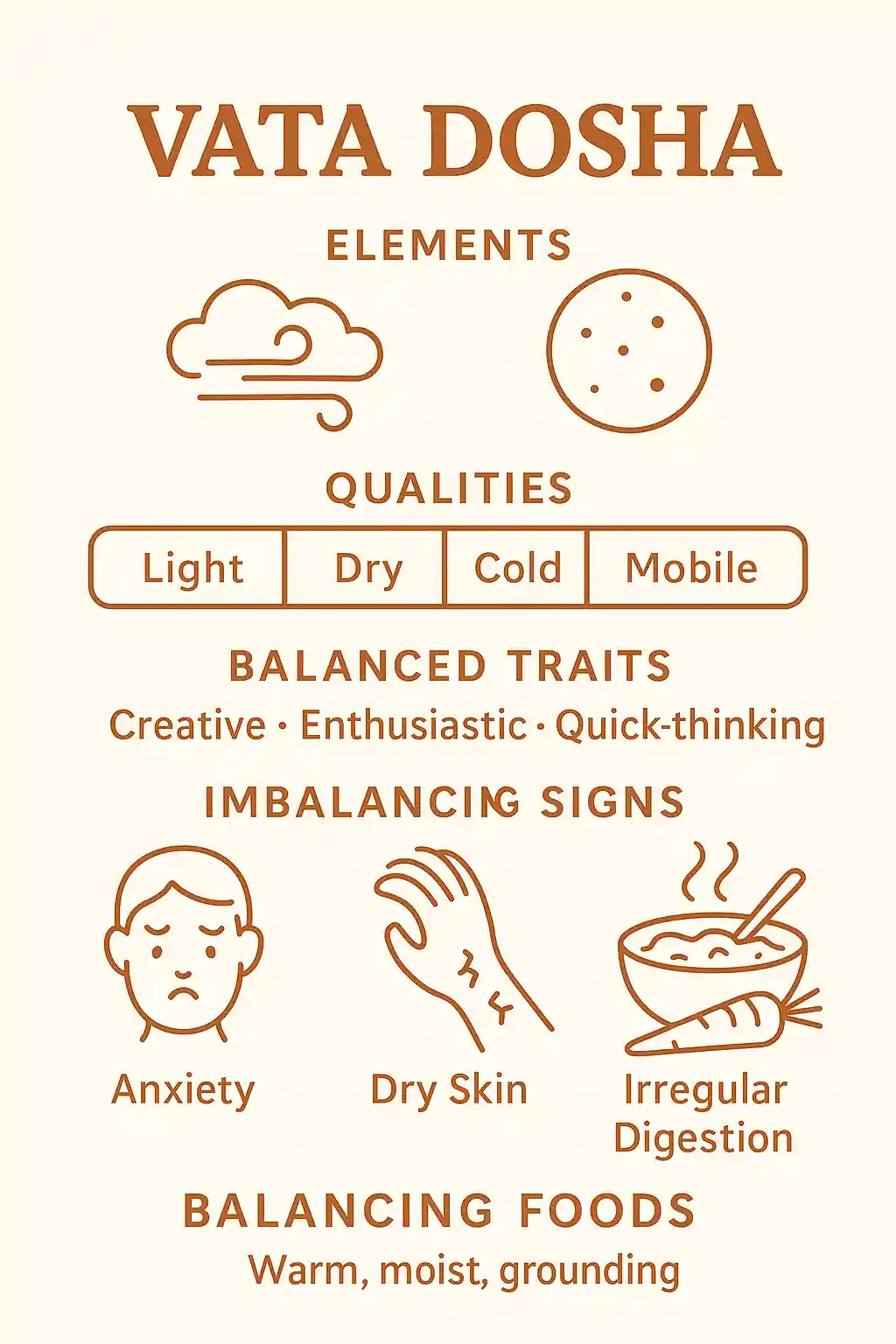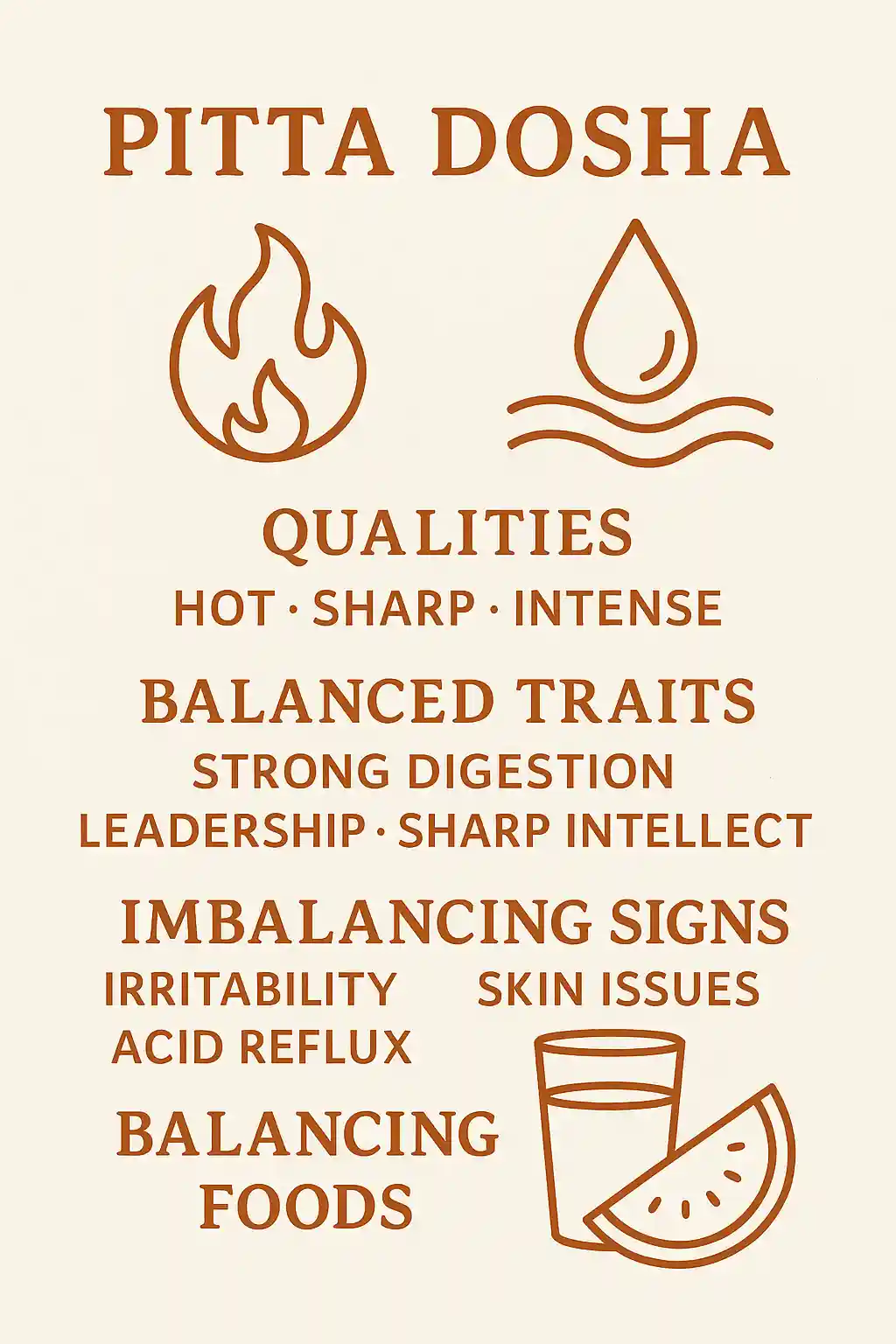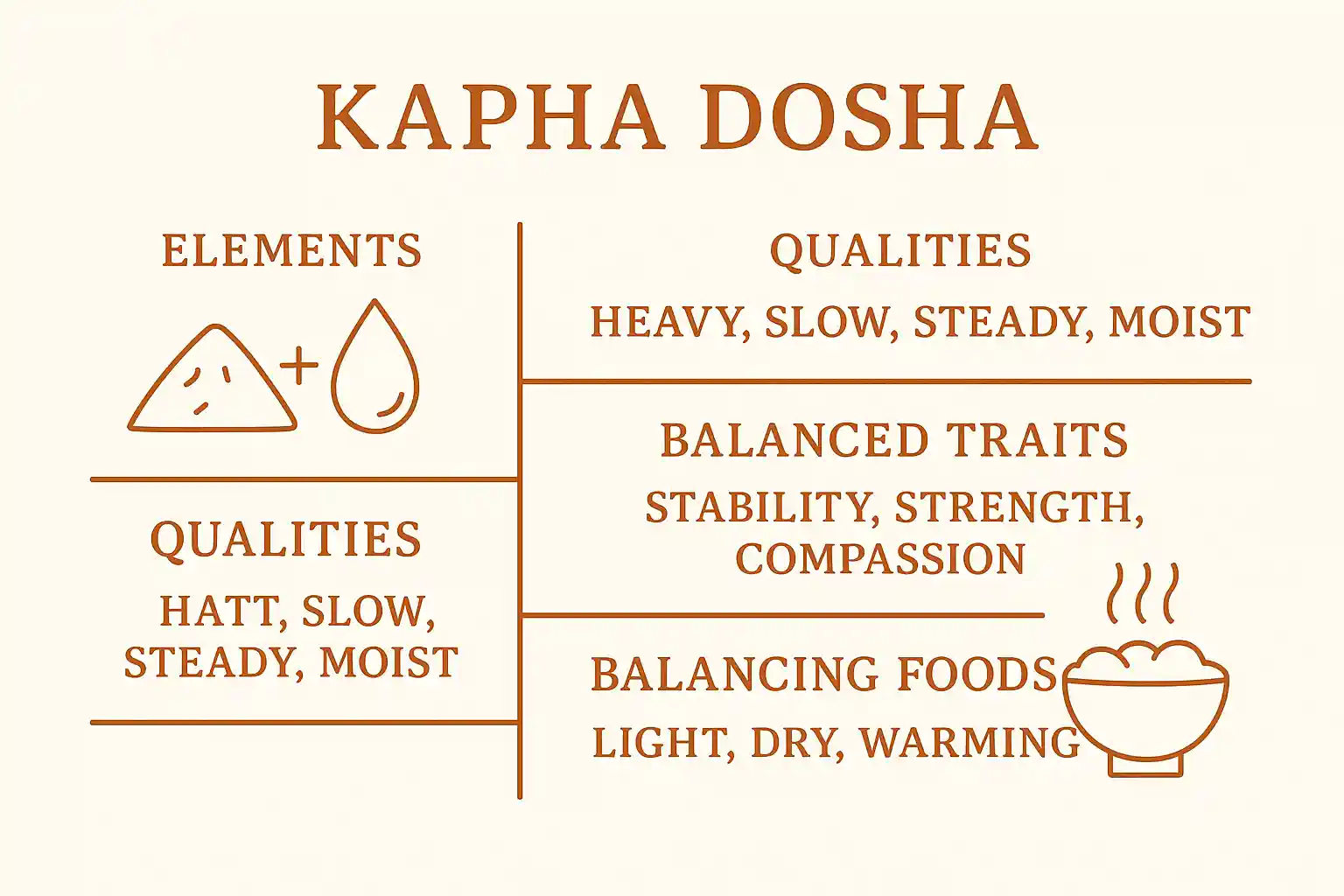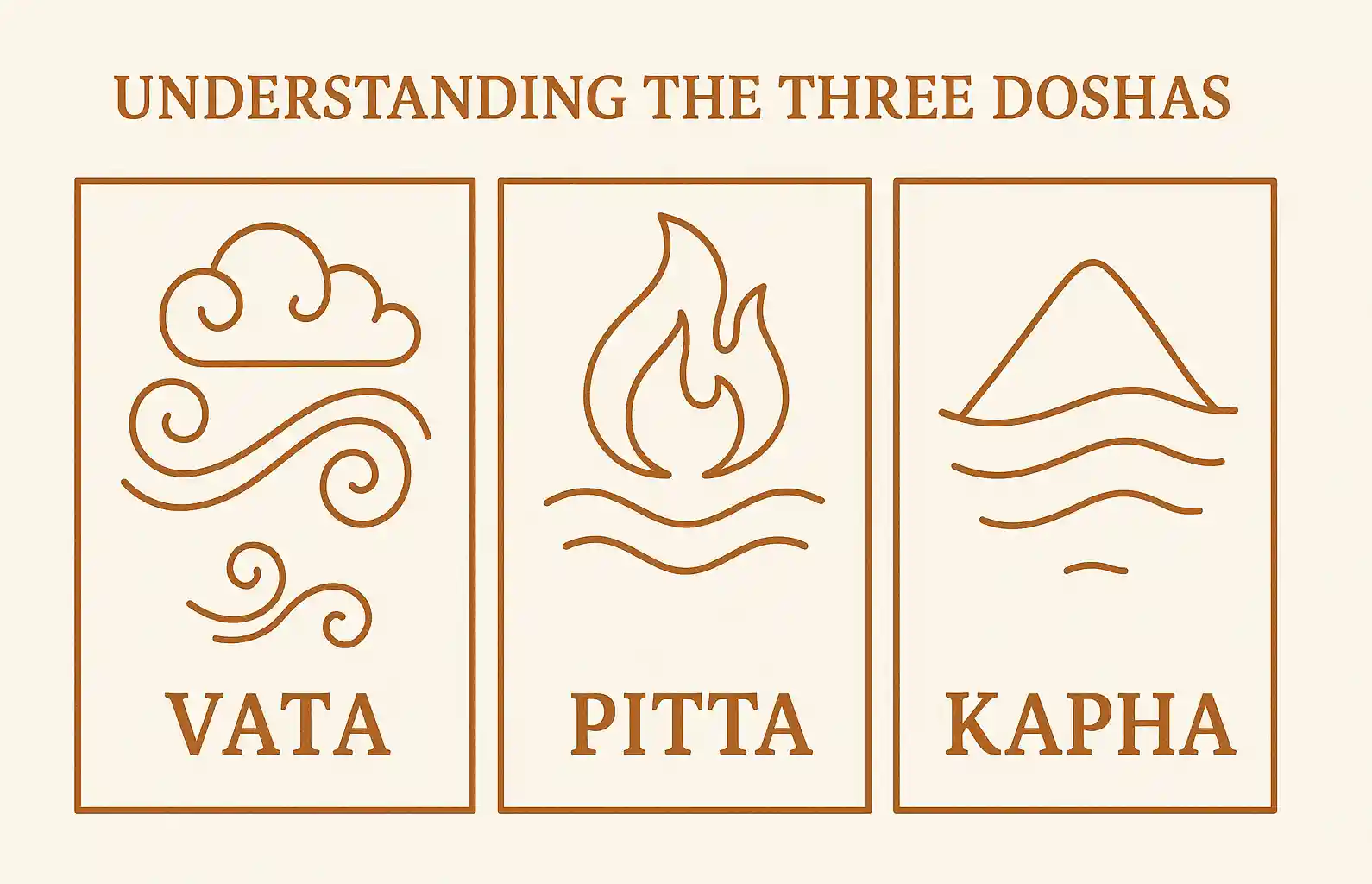What Are the Three Doshas?
Ayurveda teaches that every individual is a unique blend of three elemental energies—Vata (Air + Space), Pitta (Fire + Water), and Kapha (Earth + Water). This combination forms your Prakriti (innate constitution).
As the Charaka Samhita states: "The body is sustained by the equilibrium of the Doshas; disturbance leads to disease." (Charaka Samhita Sutrasthana 1.44)
All three Doshas exist in everyone—but optimal balance means feeling vibrant: clear digestion, steady energy, emotional equilibrium. Imbalance often shows up as fatigue, digestive irregularities, or mood swings.
The Qualities of Each Dosha
Doshas express themselves through Gunas (qualities) that influence mind, body, and digestion.
| Aspect | Vata (Air + Space) | Pitta (Fire + Water) | Kapha (Earth + Water) |
|---|---|---|---|
| Primary Qualities | Light, Dry, Cold, Mobile, Subtle | Hot, Sharp, Oily, Light, Intense | Heavy, Slow, Moist, Stable, Smooth |
| Physical Traits | Thin frame, dry skin, cold hands/feet, variable energy | Medium build, warm skin, strong appetite, muscular | Large frame, soft skin, steady energy, strong immunity |
| Mental Traits | Creative, quick-thinking, imaginative, anxious | Sharp intellect, focused, decisive, competitive | Calm, patient, loyal, methodical |
| Digestive Fire | Variable appetite, irregular digestion, gas/bloating | Strong appetite, sharp digestion, may overeat | Slow appetite, heavy digestion, may skip meals |
| Imbalance Signs | Anxiety, insomnia, constipation, dry skin | Irritability, inflammation, acid reflux, skin rashes | Lethargy, congestion, weight gain, depression |
| Balancing Foods | Warm, moist, grounding (cooked grains, ghee, stews) | Cool, hydrating, mild (cucumber, coconut, sweet fruits) | Light, dry, warming (spices, leafy greens, legumes) |
| Favorable Tastes | Sweet, Sour, Salty | Sweet, Bitter, Astringent | Pungent, Bitter, Astringent |
| Lifestyle Needs | Regular routines, warmth, grounding practices | Moderation, cooling activities, avoid excess heat | Stimulation, movement, variety, avoid excess rest |
Vata (Air + Space)

Complete Vata dosha guide - elements, qualities, traits, and balancing recommendations
Elements: Air + Space
Gunas: Light, Dry, Cold, Mobile, Subtle
Balanced traits: Creativity, clarity, adaptability
Imbalance signs: Anxiety, insomnia, dry skin, bloating, irregular digestion, constipation
Support Vata: Warm, moist, grounding foods; steady routines; warmth
Pitta (Fire + Water)

Complete Pitta dosha guide - elements, qualities, traits, and balancing recommendations
Elements: Fire + Water
Gunas: Hot, Sharp, Oily, Light, Intense
Balanced traits: Strong digestion, leadership, intelligence
Imbalance signs: Irritability, skin rashes, acid reflux, excessive hunger
Support Pitta: Cooling, hydrating foods; avoid excess heat and spice; practice moderation
Kapha (Earth + Water)

Complete Kapha dosha guide - elements, qualities, traits, and balancing recommendations
Elements: Earth + Water
Gunas: Heavy, Slow, Moist, Stable, Smooth
Balanced traits: Strength, patience, compassion
Imbalance signs: Lethargy, congestion, weight gain, sluggish digestion
Support Kapha: Light, dry, warming foods; dynamic activity; stimulation
Why Understanding Your Dosha Matters
Personalized Nutrition
Each Dosha responds best to certain foods and eating patterns. Balancing your meals to match your constitution enhances Agni (digestive fire), reduces Ama (toxins), and builds Ojas (vital essence).
Example:
- Vata: Warm, grounding meals
- Pitta: Cooling, hydrating dishes
- Kapha: Light, stimulating fare
Lifestyle Rhythms (Dinacharya)
- Vata: Steady routines, warmth, grounding practices
- Pitta: Midday exercise, cooling breaks, moderation
- Kapha: Morning activity, light meals, dynamic stimulation
Seasonal Shifts (Ritucharya)
Each season naturally affects Dosha balance:
- Spring increases Kapha → favor light, warming meals
- Summer increases Pitta → favor cooling, hydrating foods
- Autumn increases Vata → favor oily, grounding nourishment
Learn more in our Seasonal Ayurvedic Eating Guide.
How to Keep the Doshas in Balance
| Dosha | Favor | Avoid |
|---|---|---|
| Vata | Warm, moist, grounding | Cold, dry, irregular |
| Pitta | Cooling, hydrating | Hot, spicy, oily |
| Kapha | Light, dry, warming | Heavy, cold, static |
Deeper Understanding
Sub-Doshas
Each Dosha governs specific physiological and psychological functions through five Sub-Doshas, providing a more refined understanding of how these energies manifest in the body and mind:
Vata Sub-Doshas:
- Prana Vata: Governs respiration, mental activity, and sensory perception.
- Udana Vata: Controls speech, self-expression, and upward movements.
- Samana Vata: Regulates digestion and nutrient absorption.
- Vyana Vata: Circulates blood and energy throughout the body.
- Apana Vata: Manages elimination and reproductive functions.
Pitta Sub-Doshas:
- Pachaka Pitta: Oversees digestion and metabolism.
- Ranjaka Pitta: Governs blood formation and skin color.
- Sadhaka Pitta: Influences emotions, intellect, and memory.
- Alochaka Pitta: Controls visual perception.
- Bhrajaka Pitta: Manages skin metabolism and luster.
Kapha Sub-Doshas:
- Tarpaka Kapha: Nourishes the brain and nervous system.
- Avalambaka Kapha: Supports heart and respiratory strength.
- Bodhaka Kapha: Aids in taste perception and oral moisture.
- Kledaka Kapha: Protects and lubricates the stomach lining.
- Shleshaka Kapha: Maintains joint lubrication and stability.
Explore our Sub-Dosha Guide.
Vikriti vs Prakriti
Prakriti: Your innate constitution—the unique combination of Doshas determined at conception, influencing your physical, mental, and emotional traits.
Vikriti: Your current state of imbalance—the dynamic expression of Doshas as influenced by factors such as diet, lifestyle, stress, emotions, environment, and age.
Why it matters: Understanding both helps you tailor daily choices to maintain or restore balance. While Prakriti remains stable, Vikriti can shift frequently—making regular self-awareness and seasonal adjustments essential.
Doshas and Dhatus
The three Doshas interact continuously with the body's seven Dhatus (tissues):
- Rasa (Plasma)
- Rakta (Blood)
- Mamsa (Muscle)
- Meda (Fat)
- Asthi (Bone)
- Majja (Marrow/Nervous Tissue)
- Shukra/Artava (Reproductive Tissue)
Balanced Doshas ensure proper nourishment, transformation, and maintenance of these tissues. When Doshas become imbalanced, they can impair tissue formation and function, leading to poor vitality and accumulation of Mala (waste).
Ojas, Tejas, and Prana
These three subtle essences represent the refined forms of Doshas and Dhatus, supporting deeper levels of vitality and consciousness:
- Ojas (Vital essence): The supreme essence of all Dhatus; sustains immunity, vitality, and emotional stability. Signs of strong Ojas include radiant skin, clear eyes, robust immunity, and resilience.
- Tejas (Metabolic intelligence): The subtle essence of Pitta; governs digestion, cellular metabolism, and mental clarity. Balanced Tejas supports discernment and emotional clarity without inflammation.
- Prana (Life force): The subtle essence of Vata; orchestrates breath, nervous system function, and higher states of consciousness. Balanced Prana promotes vitality, creativity, and a calm, alert mind.
In harmony: When Doshas are balanced and Dhatus are well-nourished, Ojas, Tejas, and Prana flourish—supporting physical health, mental clarity, and spiritual growth.
Modern Science & Ancient Wisdom
Modern research increasingly supports Ayurvedic insights:
- Circadian biology: Aligning meal timing with body rhythms supports metabolism—an ancient Ayurvedic principle.
- Seasonal mood studies: Shifts in mood and physiology align with Ritucharya.
- Temperament research: Western psychology mirrors Dosha patterns in personality traits.
References:
- Garaulet M, et al. Chronobiology and nutrition. Adv Nutr. 2013.
- Kantermann T, et al. Circadian misalignment influences mood and cognition. Biol Psychol. 2010.
Final Thoughts
Understanding your Dosha is a foundational step in Ayurveda—one that empowers you to shape a personalized wellness path through food, rhythms, and self-awareness.
Start with small shifts. Observe how your body responds. Ayurveda is a lifelong journey of tuning into your body's needs.
Frequently Asked Questions
Common questions about understanding and working with your dosha constitution
Vata: Prana, Udana, Samana, Vyana, Apana
Pitta: Sadhaka, Alochaka, Bhrajaka, Ranjaka, Pachaka
Kapha: Tarpaka, Avalambaka, Bodhaka, Kledaka, Shleshaka
Continue Your Learning Journey
Master the foundations of Ayurvedic eating with our structured learning path
Next: Learn about compatible food pairings and digestive harmonyReady to take the next step?
Sources & Further Reading
Classical Texts
Educational Resources
Related Articles

Understanding Kapha Dosha: The Foundation of Strength and Stability
Discover Kapha Dosha, the grounding force of Earth and Water elements. Learn how this vital energy provides structure, immunity, and emotional stability—and how to keep it balanced.
8 min read
Understanding Vata Dosha: The Energy of Movement and Change
Discover the dynamic energy of Vata dosha - the force of movement, creativity, and transformation. Learn to recognize Vata characteristics, identify imbalances, and master the art of grounding this powerful yet delicate constitutional type.
12 min read
